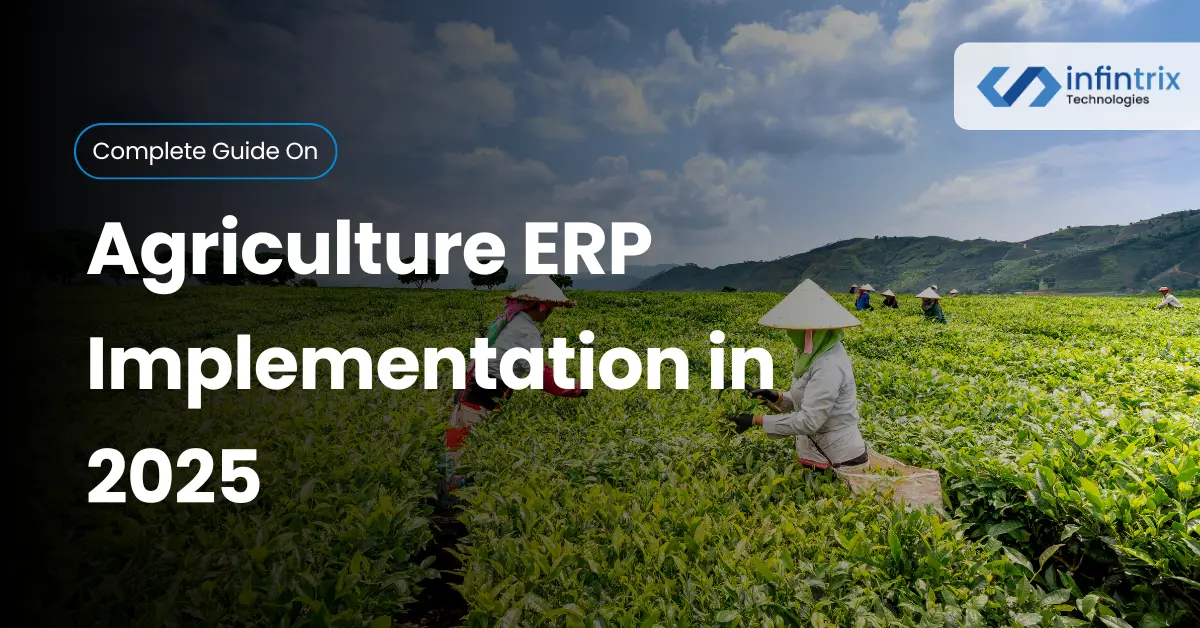Running a modern farm isn’t just about soil, weather, or seeds anymore — it’s about data, efficiency, and real-time decisions. As agribusinesses scale, managing production, finance, and supply chains through spreadsheets or manual logs becomes risky and slow. That’s where Agriculture ERP Implementation comes in.
In 2025, agriculture ERP systems like Odoo, ERPNext, and Oracle NetSuite are transforming how farms operate — from crop planning to accounting. They connect every process under one roof, helping you track field activities, inventory, and finances with accuracy and confidence. This guide walks you through the complete implementation process — practical, clear, and focused on results.
Understanding Agriculture ERP and Its Importance in 2025
Agriculture ERP software is more than a digital tool — it’s the central nervous system for your farm. It brings together core processes like farm management, crop tracking, financial reporting, and supply chain coordination into one integrated platform.
By 2025, digital transformation isn’t a choice; it’s a necessity. Climate unpredictability, regulatory demands, and cost pressures require real-time control. ERP platforms help farmers achieve that — whether through IoT integration, precision agriculture insights, or yield analysis dashboards that improve decision-making across every acre.
What Is Agriculture ERP?
An Agriculture ERP (Enterprise Resource Planning) system connects your field, warehouse, and finance teams.
It typically includes modules for:
- Farm and crop management – planning, monitoring, and yield tracking.
- Inventory management – seeds, fertilizers, and pesticides.
- Financial management – cost analysis, accounting, and forecasting.
- Supply chain management – traceability from harvest to distribution.
In simpler terms, ERP software gives your agribusiness a single view of performance — from the soil to the spreadsheet.
Why ERP Matters Now
In 2025, data-driven agriculture is no longer limited to large corporations. Even mid-sized farms are adopting ERP systems to stay competitive. Here’s why:
- Operational transparency: You can see what’s happening on every plot, in real-time.
- Traceability and compliance: Meet FSMA, GAP, and other standards easily.
- Automation: Eliminate manual records, duplication, and guesswork.
- Better decisions: Access instant insights on yield, input costs, and profitability.
Without ERP, running a farm is like tracking hundreds of moving parts on sticky notes — things will get lost fast.
Key Benefits of Agriculture ERP Systems
An agriculture ERP implementation doesn’t just digitize operations — it redefines how you manage productivity and profitability. By centralizing farm data, you gain actionable insights and tighter control over every resource.
Improving Farm Productivity
With an ERP like ERPNext or Odoo, farmers can monitor irrigation levels, forecast yield, and schedule tasks efficiently. Real-time dashboards help identify underperforming areas and optimize resource allocation — ensuring no seed, fertilizer, or man-hour goes to waste.
Streamlining Operations and Finance
ERP software connects finance, logistics, and production in a single system. That means no more reconciling multiple spreadsheets or waiting for month-end reports.
| Process | Manual Method | ERP Workflow |
| Purchase Orders | Delays and paper-based | Instant digital approval |
| Inventory Tracking | Disconnected lists | Real-time updates |
| Financial Reporting | Weeks of delays | Instant dashboards |
The difference is clear: ERP replaces complexity with clarity.
Ensuring Traceability and Compliance
From ERP o final sale, every step can be tracked digitally. This enhances traceability — critical for certifications and audits. ERP systems also help automate compliance documentation for FSMA and GAP, saving countless hours and reducing human error.
At Infintrix Technologies, our team has seen how ERP systems simplify regulatory audits — one of the biggest challenges farms face during expansion.
Step-by-Step Agriculture ERP Implementation Roadmap
Implementing an agriculture ERP is like cultivating a new crop — success depends on planning, timing, and care. The following roadmap helps ensure your ERP deployment grows smoothly from concept to completion.
1. Assess Business Needs
Before choosing a platform, identify your farm’s biggest challenges. Are you struggling with inventory visibility, cost tracking, or harvest planning?
Conduct an internal audit to map out:
- Current processes and pain points
- Data silos between departments
- Compliance or reporting gaps
This discovery phase defines your ERP goals and avoids costly rework later.
2. Choose the Right ERP Platform
Once your needs are clear, evaluate solutions that fit your operation size and structure:
- Odoo – modular, flexible, ideal for medium to large agribusinesses.
- ERPNext – open-source, customizable for small to mid-sized farms.
- Oracle NetSuite – enterprise-grade for multi-branch agro-industries.
Focus on scalability, user-friendliness, and local support — not just flashy features.
3. Plan Data Migration
Migrating decades of farm records, inventory lists, or ledgers into ERP requires accuracy.
Clean, categorize, and test data before import. Start with pilot datasets to catch errors early.
Pro tip: Maintain backups of your original files for at least 6 months post-migration.
4. Customize and Configure Modules
Tailor ERP modules to your specific operations — crop cycles, seasonal demand, regional compliance, or export logistics.
At Infintrix Technologies, we’ve seen farms benefit most when they start small — implementing core modules first, then scaling with CRM, HR, or mobile dashboards once users are confident.
5. Train Users and Build Adoption
ERP success depends on people, not software.
- Conduct training sessions for field managers and accountants.
- Create SOPs and role-based access.
- Provide a support window after go-live for troubleshooting.
A well-trained team ensures sustainability beyond the first harvest cycle.
6. Test, Go Live, and Optimize
Before full launch, run UAT (User Acceptance Testing) with real data. Check reports, approvals, and mobile syncing.
After go-live, monitor KPIs such as inventory accuracy, input costs, and yield variance to measure ROI.
Common Challenges During Implementation
Even the best agriculture ERP face chllanges and hurdles. Knowing them early helps you prepare smartly.
| Challenge | Why It Happens | How to Overcome |
| Resistance to change | Staff fear new systems | Provide early training and clear benefits |
| Data inconsistency | Poor records or duplicates | Conduct audits before migration |
| Over-customization | Trying to mirror old habits | Keep workflows simple and standardized |
| Lack of expert support | No implementation partner | Partner with certified ERP consultants |
Many agribusinesses in Pakistan and U.S have reduced ERP downtime by partnering with experienced teams like Infintrix Technologies, ensuring technical precision and local support.
How to Choose the Right Implementation Partner
Your ERP partner is as critical as the software itself. Choose one that understands both agriculture operations and ERP architecture.
Look for:
- Proven industry case studies
- Transparent project timelines
- Ongoing support and updates
- Ability to localize features for regional compliance
The best partner guides your team through every step — from discovery to optimization — ensuring your ERP becomes a growth engine, not just a reporting tool.
Conclusion
By 2025, ERP adoption in agriculture is moving from optional to essential. Whether you’re managing a dairy farm, greenhouse, or export-focused agribusiness, an ERP connects your fieldwork with financial intelligence — improving traceability, compliance, and profitability.
Working with an expert implementation team such as Infintrix Technologies can make the transition smoother, ensuring your digital foundation grows as steadily as your crops.
FAQs on Agriculture ERP Implementation
1. How long does an agriculture ERP implementation take?
Typically 3–6 months, depending on data size, customization, and team readiness.
2. Which ERP is best for small-scale farms?
ERPNext or Odoo Community versions offer flexibility and low cost for smaller setups.
3. Can I integrate IoT devices or weather sensors?
Yes. Modern ERPs like ERNext and Odoo support IoT for live soil, temperature, and humidity data.
4. What’s the average cost of ERP implementation?
From USD 5,000 to 30,000 based on modules, users, and partner support level.
5. Why choose Infintrix Technologies for ERP implementation?
Because our team combines agriculture domain experience with tech

